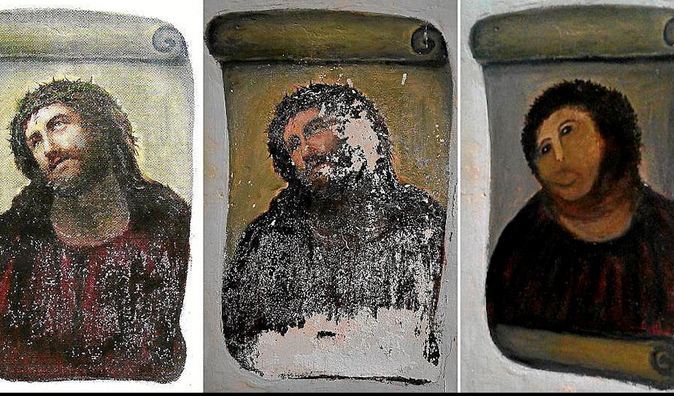This Sunday marks
the tenth anniversary of the failed attempt to restore the Eccehomo painting
, located in the Misericordia Sanctuary of Borja (Zaragoza).
It is a worldwide known phenomenon that has been visited by some
300,000 people from 130 countries
.
It has generated income of 450,000 euros, including tickets, image rights and the sale of various items.
The protagonist,
Cecilia Giménez Zueco, 91 years old
, fond of painting, is in poor health and lives with her son who suffers from cerebral palsy in a residence.
She continues to receive messages of affection from all over the world, she says that she is left with the joy of knowing that
people love
her and assures that she would try to repair the painting.
The Borja City Council has organized
a gala to commemorate the tenth anniversary in September in which Cecilia will be honored
.
It all started when the newsletter of the Centro de Estudios Borjanos published two photographs with the before and after of the mural painting, the work of
Elías García Martínez
.
He was a renowned painter and teacher who decorated the ceiling of the Teatro Principal in Zaragoza and collaborated with the Gran Teatro del Liceo in Barcelona.
The painting,
an oil on the wall
, about 50 centimeters high by 40 wide, was made in the twenties of the last century while he was spending the summer in Borja, where the family is from.
On August 21, 2012,
Heraldo de Aragón
echoed the
"mess"
, the "botched", then the news jumped nationally and later
went around the world
.
When
Cecilia
returned from a trip on the Imserso, she found the commotion that had been created.
In her defense, she argued that she had already done it "other times" and that
they had not allowed her to "finish the restoration"
.
However, she acknowledged: "she has gotten out of hand."
At first, criticism rained down on him everywhere and the City Council and
the painter's family announced lawsuits against the impromptu restorer
.
Then there was a discussion about whether to complete the restoration of the painting or if it was better to leave it as it was.
FROM A WINE LABEL TO AN OPERA
The deformed figure has been stamped on
wine labels, key rings
, teddy bears, thimbles, t-shirts, mobile applications, computer mouse pads or candies by a Japanese company.
The reinterpretation of
Eccehomo generates income of around 45,000 euros a year
, the result of the sale of merchandising items, image rights and tickets to the sanctuary to see the painting.
Part of the income generated
by the memorabilia is for Cecilia
with which she pays for her stay in her residence and that of her son who suffers from cerebral palsy.
The rest of the funds are managed by the
Sancti Spiritus charitable foundation,
whose patronage is chaired by the mayor, who is in charge of the Misericordia Sanctuary, in one of whose chapels is the
Eccehomo
, and a nursing home.
With this money, the foundation hires two ticket saleswomen,
the church is open every day of the year
, contributes funds to the residence and pays part of the stay for elderly people with limited resources.
Cecilia and her Eccehomo
have inspired various cultural initiatives: documentaries, doctoral theses, appearances in films, books, songs, comics and an opera in a humorous tone.
Composed by the American director Andrew Flack,
Behold the Man
(This is the man and, in Latin, Eccehomo),
has been presented in Arizona
(United States) and will be released in 2023 in Las Vegas.
The singer-songwriter Ángel Petisme dedicated a song to her and
Cecilia starred in the music video for the song Eccehomo
, included on the album El Ministerio de la feliz.
The first International
Eccehomo
Museum was created in Borja , which has 26 unpublished paintings on this work by authors from different parts of the world, from Mexico to Italy, and mainly from Spain.
In 2016, the Eccehomo Interpretation Center
was inaugurated
, a space dedicated to the study of this media phenomenon.
The entrance to the Sanctuary includes a visit to the church where the painting is located and to the interpretation center.
In addition, it has been possible for
those who come to Borja for the claim of painting to visit the many attractions
that the town has, such as the Collegiate Church and its museum or the Archaeological Museum.
Cecilia Giménez
, a widow, lives with her son José Antonio, in a public residence located at the entrance to the town.
A few years ago a stroke paralyzed the right part of her body and since then she has been forced to
move around in a wheelchair
.
She remembers what happened sometimes with joy and sometimes with sadness.
She assures that she remains with the affection and
respect that people have shown her
.
She is happy for her because she is known all over the world as Cecilia la del Eccehomo.
He became one of the most famous personalities of 2012, along with Barack Obama, Vicente del Bosque or Leo Messi, among others.
The Misericordia sanctuary, a 16th-century building, is located on the
outskirts of Borja
, about five kilometers away, on the side of a mountain with pine trees and small residential houses.
The fire, which a few days ago affected several municipalities of Moncayo and
burned 6,000 hectares
, was at the gates of the sanctuary and burned the wooded area, forcing it to close for several days.
Now it is open and ready to receive new visitors in a phenomenon that does not stop.
Conforms to The Trust Project criteria
Know more
Aragon
art

